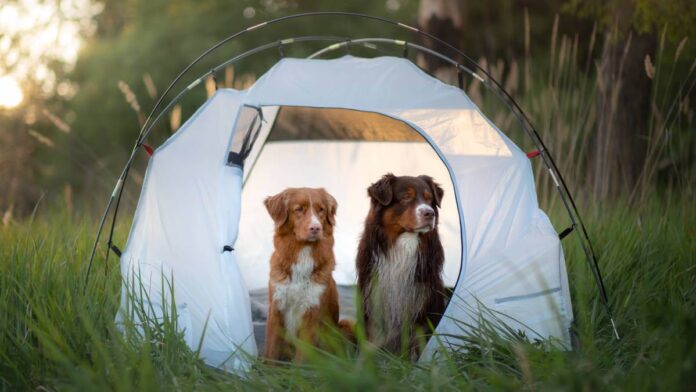So, you are off on a camping holiday, but don’t want to leave man’s best friend behind.
Fair enough, they are probably a part of the family anyway, and kennels are expensive.
But camping with a dog isn’t as simple as whistling Fido into the back seat and heading off to your favourite campsite.
Here’s our guide to getting the most out of your next camping holiday with your dog.
It’s generally stated that pets aren’t allowed in national parks, but that’s not a blanket rule. Some parks will allow dogs, but almost always not for camping and they have to be on a leash.
What’s the problem, you say, my dog is a sweetie.
As well as the danger to native animals if they are attacked by dogs, many national parks also have poisonous bait programs for feral dogs and foxes that could be fatal to your pet.
Check the national park website in your state for which parks and reserves allow dogs.
Is your pet up to it?
Think long and hard about taking your pet on holiday with you. Sure, you love little Fluffy and will put up with his foibles, but it’s not fair to others if your dog likes to rush other dogs or will not return to you on command.
If your pet is not well socialised, barks a lot and won’t follow your orders, best to leave them at home.
And some dogs just aren’t suited to camping. I’ve seen many pets that shouldn’t be out of their yard, let alone in a high-contact area like a busy campsite.
Before you go
It’s worth visiting your vet before you go for a once-over, and to make sure your pet is up to date with its vaccinations and has been wormed. You should also have it microchipped and make sure it has contact details on its collar.
It also may be a good idea to get your dog groomed. Long hair can be a nightmare to deal with if you are in a tick area and can also be a risk for grass seeds.
If you are camping in a tick area for the first time, look up how to search for ticks and how to remove them safely.
There is some good advice about ticks from the CSIRO here.
Before you go, find the nearest vet to your campsite and jot down their details. It could save you time and panic, especially if your destination has sketchy internet coverage.
If you have pet insurance, check your policy to see if it covers travelling and camping.
Kit up
If you are camping, you are going to need some pet supplies to get you through. There’s probably not going to be a vet or supermarket on hand to ease your concerns.
Your kit should probably at the very least include a bed, anti-tick and anti-flea spray, some bandages and antiseptic cream, any relevant paperwork on the dog’s health, poo bags, collapsible travel bowls and tweezers.
Naturally, you should also bring enough food and treats plus some extra and make sure to dispose of any leftover food carefully as it can be dangerous for native animals.
Camp rules
Thankfully there are hundreds, possibly thousands, of places that allow you to take your pet, both public and private. However, there is no one set of rules covering all pet-friendly accommodation and camping spots, so you should always check what’s allowed before booking or heading off.
Parks and camping grounds that allow pets are also popular, so you may have to book well ahead.
It’s a good idea to join a few Facebook camping groups as they are an excellent source of information on pet-friendly camping areas and their rules.
Things you don’t necessarily need, but are a good idea
- glow sticks to attach to your dog’s collar at night so they are easy to see
- dog sunscreen and sunglasses if you are spending time at the beach
- old dog toys to play with
- grooming kit such as a brush and an old towel. Dogs can get messy out in the bush.
Have you ever been camping with your pet? Why not share your tips in the comments section below?
Also read: Five favourite locations to go camping in Australia

